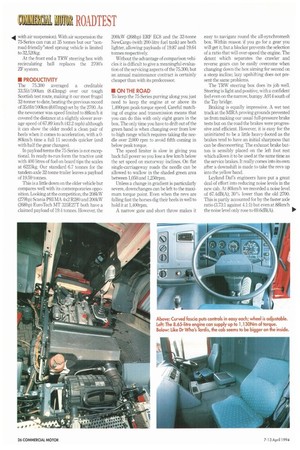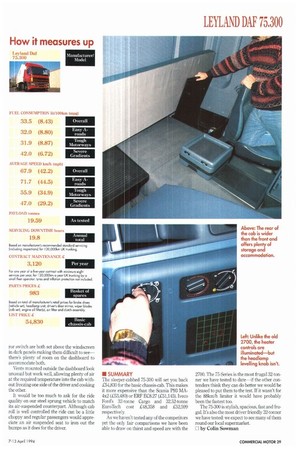TOPS FOR THE SHOP
Page 26

Page 28

Page 30

Page 31

If you've noticed an error in this article please click here to report it so we can fix it.
Don't be surprised if the next 32-tonne artic you see in supermarket livery is a Leyland Daf 75.300. This frugal successor to the 2700 has the right performance and image for a high-profile sector.
Every now and then a truck comes along that is so distinctive you can spot it a mile away. Leyland Daf's 75/85 Series falls into this category: no matter which way you approach it, you can tell what it is long before you can read the badge.
Launched at the Hanover show in 1992, the 75 and 85 Series low-height cabs are designed for distribution and general haulage work. leaving the 95 Series to compete in the premium long-haul tractor market. Engines are also matched to the workload, with the 8.6litre for the 75 Series and 11,6-litre for the higher weight 85 Series (the 95 gets the new the 373kW/500hp 14-litre).
To evaluate the new breed of mid-range tractive units we drove a 75-Series tractor. With its distinctive flared wings it stirs childhood memories of your favourite pull-along duck. A less intimidating cab it is difficult to imagine; this is a far cry from the house-brick styling of the 2700 tractive unit it replaces.
• PRODUCT PROFILE Our test vehicle is a 32-tonner fitted with the highest powered (222kW/298hp) Euro-1 engine—a vehicle unashamedly aimed to the high-profile supermarket sector In the engine's evolution from eight to 8.65 litres its cylinder heads were turned round and the stroke increased to 132mm. The enlarged engine comes in three power ratings: as well as the 222kW version operators can opt for 180 and 200kW (241 and 268hp). Gone is the distinctive engine note of the 2700, but with the 222kW unit pushing out peak torque of 1,130Nm (at 1,400rpm), not many drivers will complain.
Daf claims specific fuel consumption of below 200g/kWh over the usable rev range with the low point at 1,600rpm. Coupled with the torque curve this gives a green band of 1,250-2,000rpm; the dotted green extends down to 1,050rpm.
Our vehicle came with the standard ninespeed ZF 9S-109 Ecomid using Daf's usual lifting collar arrangement for the range change (ZF's 16-speed range change splitter box is optional). Final drive is via Daf's 1339 single-reduction rear axle with a standard ratio of 3.73:1 (4.1:1 optional).
Although the 75 Series has the same design weight as its predecessor, its flat-topped chassis has been stiffened by using thicker section steel (7.0mm against 6.5mm). Side-rail dimensions are unchanged from the 2700 at 260x75mm. When laden the chassis height for the steel suspended vehicle is 960mm (970 011•
with air suspension). With air suspension the 75-Series can run at 35 tonnes but our "nonroad-friendly"steel sprung vehicle is limited to 32,520kg.
At the front end a TRW steering box with recirculating ball replaces the 2700's ZF system.
• PRODUCTIVITY
The 75.300 averaged a creditable 33.51it/100km (8.43mpg) over our tough Scottish test route, making it our most frugal 32-tonner to date, beating the previous record of 35.01it/100km (8.07mpg) set by the 2700. As the newcomer was speed limited to 881m/hit covered the distance at a slightly slower average speed of 67.89 km/h (42.2 mph) although it can show the older model a clean pair of heels when it comes to acceleration, with a 080km/h time a full 11 seconds quicker (and with half the gear changes).
In payload terms the 75-Series is not exceptional. In ready-to-run form the tractive unit with 400 litres of fuel on board tips the scales at 6225kg. Our standard 6.7 tonnes for the tandem-axle 32-tonne trailer leaves a payload of 19.59 tonnes.
This is a little down on the older vehicle but compares well with its contemporaries opposition. Looking at the competition, the 208kW (279hp) Scan ia P93 MA 4x2 R280 and 200kW (268hp) EuroTech MT 325E27T both have a claimed payload of 19.4 tonnes. However, the 200kW (268hp) ERF EC8 and the 32-tonne NewCargo (with 200-litre fuel tank) are both lighter, allowing payloads of 19.87 and 19.64 tonnes respectively.
Without the advantage of comparison vehicles it is difficult to give a meaningful evaluation of the servicing aspects of the 75.300, but an annual maintenance contract is certainty cheaper than with its predecessor.
• ON THE ROAD
To keep the 75-Series purring along you just need to keep the engine at or above its 1,400rpm peak-torque speed. Careful matching of engine and transmission means that you can do this with only eight gears in the box. The only time you have to drift out of the green band is when changing over from low to high range which requires taking the needle over 2,000 rpm to avoid fifth coming in below peak torque.
The speed limiter is slow in giving you back full power so you lose a few km/h below the set speed on motorway inclines. On flat single-carriageway roads the needle can be allowed to wallow in the shaded green area between 1,050 and 1,250rpm.
Unless a change in gradient is particularly severe, downchanges can be left to the maximum torque point. Even when the revs are falling fast the horses dig their heels in well to hold it at 1,400rpm.
A narrow gate and short throw makes it easy to navigate round the all-synchromesh box. Within reason if you go for a gear you will get it, but a blocker prevents the selection of a ratio that will over-speed the engine. The detent which separates the crawler and reverse gears can be easily overcome when changing down the box aiming for second on a steep incline; lazy upshifting does not present the same problems.
The TRW steering box does its job well. Steering is light and positive, with a confident feel even on the narrow, bumpy A914 south of the Tay bridge.
Braking is equally impressive. A wet test track at the MIRA proving grounds prevented us from making our usual full-pressure brake tests but on the road the brakes were progressive and efficient. However, it is easy for the uninitiated to be a little heavy-footed as the brakes tend to have an initial sharpness that can be disconcerting. The exhaust brake button is sensibly placed on the left foot rest which allows it to be used at the same time as the service brakes. It really comes into its own after a downshift is made to take the revs up into the yellow band.
Leyland Daf's engineers have put a great deal of effort into reducing noise levels in the new cab. At 80km/h we recorded a noise level of 67.4dB(A); 30% lower than the old 2700. This is partly accounted for by the faster axle ratio (3.73:1 against 4.1:1) but even at 88km/h the noise level only rose to 69.6dB(A).
ACAB COMFORT
Climbing into the cab is made easy with a couple of steps and well positioned grab handles (climbing back out is not so easy).Once installed the first thing that strikes the driver is the view afforded by the large side windows and angled A-posts. Although the engine protrudes some way into the cab there is no feeling of being shoehorned into the driving seat.
Like Dr Who's Tardis, the cab seems to be larger on the inside than the outside. This illusion comes from the 190mm for-aft taper: the smaller frontal area tends to stick in the mind but the wider rear makes room for a good sized bunk.
Grey and blue trim add to that feeling of space as does the fascia, which is curved enough to give easy access to the controls without alienating the passenger.
Storage space is adequate with over-windscreen map pockets in the centre and offside. The centre console has pockets for drinks and tapes; extra space is available via optional storage boxes.
The controls are generally easy to operate but shorter drivers will find the accelerator pedal a bit of a stretch, even with the seat fully forward.
Unlike the old 2700 the steering column is adjustable and the heater controls are illuminated, but this illumination does not extend the headlamp levelling knob on steel suspended vehicles The black radio and heated mir ror switch are both set above the windscreen in dark panels making them difficult to see— there's plenty of room on the dashboard to accommodate both.
Vents mounted outside the dashboard look unusual but work well, allowing plenty of air at the required temperature into the cab without freezing one side of the driver and cooking the other.
It would be too much to ask for the ride quality on our steel sprung vehicle to match its air-suspended counterpart. Although cab roll is well controlled the ride can be a little choppy and regular passengers would appreciate an air suspended seat to iron out the bumps as it does for the driver. • SUMMARY
The sleeper-cabbed 75-300 will set you back 154,830 for the basic chassis-cab. This makes it more expensive than the Scania P93 MA4x2 (153,480) or ERF EC8.27 (151,145). Iveco Ford's 32-tonne Cargo and 32.52-tonne EuroTech cost 148,358 and 152,599 respectively, As we haven't tested any of the competitors yet the only fair comparisons we have been able to draw on thirst and speed are with the
2700. The 75-Series is the most frugal 32-tonner we have tested to date—if the other contenders think they can do better we would be pleased to put them to the test. If it wasn't for the 88km/h limiter it would have probably been the fastest too.
The 75-300 is stylish, spacious, fast and frugal. It's also the most driver friendly 32-tonner we have tested: we expect to see many of them round our local supermarket.
Lii by Colin Sowman


















































































